|
|
DAVID ROBINSON'S SYSTEM
LOUDSPEAKERS
Von Schweikert VR-9SE loudspeakers; Nova Rendition II loudspeakers outfitted
with Walker Audio High Definition Links (HDLs) on the upper bi-wire, and
Townshend Audio Supertweeters; all contacts treated with Walker Audio
Enhanced SST Contact Enhancer.
ELECTRONICS
Red Rock Audio Renaissance monoblock amplifiers; Linn Klimax monoblock
amplifiers; Wavac PR-T1 preamplifier; Joule Electra LA-150 line stage
preamplifier; EMM Labs Switchman-3 (SWM-3) 2/6 channel preamplifier; Linn
Klimax Kontrol preamp; Walker Audio Reference Phono Amplifier; Joule Electra
OPS-2 dual mono phono amplifier; Aesthetix Rhea phono amplifier; E.A.R. 324
phono amplifier.
SOURCES
DIGITAL: EMM Labs DAC6e 2/6 channel DSD D/A; EMM Labs CDSD SACD/CD
Transport; EMM Labs Philips SACD 1000 w/optical DSD and PCM output (2/6
channel); Linn CD-12; Theta Digital Pro Gen Va D/A converter; Panasonic
SV-3900 DAT player with Vimak DS-500 A/D converter; Tube Research Labs
modified Sony SCD-CD595 SACD player.
ANALOG: Walker Audio Proscenium Gold Signature reference turntable system with the Magic Diamond cartridge and direct connection to the Walker Audio
Reference Phono Amp (upgraded to the latest version, with the Walker Audio
Power Supply, Second Edition, also upgraded to the latest revision, both as
of 09/2005); Linn LP-12 turntable, with the Akiva reference cartridge, Ekos
tonearm, the new Lingo power supply, Cirkus subchassis, and Linn reference
silver phono cable; Revox B-77 Mk. II 15 ips half-track reel-to-reel tape
recorder; Pioneer RT-707 7.5 ips quarter track reel-to-reel tape recorder;
Nakamichi Dragon reference cassette deck; Magnum Dynalab FT-101 tuner w/Audioprism
6500 internal antenna.
HEADPHONES
Beyer Dynamic DT-990 headphones.
CABLES
Interconnects by JENA Labs, Cardas, Omega Mikro, Harmonic Technology,
Empirical Audio, Kimber, and Linn. Speaker cables by JENA Labs, Cardas,
Omega Mikro, Kimber and Linn. Power cables by JENA Labs, Cardas, Omega Mikro,
First Impression Music, Kimber, Silent Source, and VansEvers.
ACCESSORIES
Walker Audio Prologue Rack; Walker Audio Component Stands; Walker Audio
Valid Points and Valid Points tuning kits; three Walker Audio Velocitors
(latest version, upgraded as of 09/2005) on Velocitor Stands (line
conditioning for Walker Audio Proscenium turntable system and its associated
Linn Kontrol preamp); Walker Audio equipment stands; Vibraplane turntable
isolation platform; Sistrum SP-101 amplifier stands and SP-4 multiple
platform rack; Black Diamond Racing "The Shelf" and cones; Extremephono VCS
Platforms w/Black Diamond Racing cones under the Switchman-3; JENA Labs
Fundamental Power 6.1 revised (line conditioning for SACD and CD sources and
selected electronics); Dedicated Audio Cable Tower cable supports; equipment
racks by Walker Audio, Michael Green, Sistrum, and Target; Shakti Stones and
Shakti Onlines; Tice Signature III Power Block (line conditioning for
tertiary sources), VansEvers Clean Line; VPI 17F LP cleaning system with the
latest Record Research Lab LP cleaning/deep cleaning systems; Disc Doctor
Miracle Record Cleaning System; Walker Audio Ultimate SST Contact Enhancer;
latest version (09/2005) of the Walker Audio Vivid SACD/DVD/CD enhancer;
Record Research Labs Shine-Ola SACD/CD surface treatment; Bedini Ultra
Clarifier; and acoustical treatments by ASC, VansEvers, and Michael Green.
|
|
Note to Virginia
Yes, Virginia, I'm still very much in love with
vinyl and turntables.
No, my passion for DSD and SACD do not mean
that I have no room in my heart for LPs. And for open reel tapes, too. (Now
there's romance for you.)
As a matter of fact, dear child, the past year and a
half has allowed me to get two turntables into my listening room, in addition to
my fully tricked-out Linn LP-12: the SOTA Millennia with SME 4.5i tonearm,
Cardas Neutral Reference Phono Cable, and Cardas Myrtle Heart MC cartridge,
and the Walker Audio Proscenium system. Each takes a different approach to
turntable playback; each will appeal to different listeners; each lives at a
different price point. (My review of the Walker Proscenium Gold Signature
turntable system will be published elsewhere in this issue, shortly after this
review of the SOTA Millennia/SME/Cardas appears.)
In my review of the Walker Proscenium Gold Signature
system, you'll see my full venting of the trials and tribulations of sourcing
reference grade turntables for review. There's no point in publishing that rant
twice, much as I might want to. I'm just glad to say that I didn't have the sort
of dead-end problems sourcing a system from SOTA that I experienced with other
companies. After some very helpful preliminary conversations with Kirk and
Donna Bodinet, the principals at SOTA, we finally agreed on a project
involving their flagship Millennia turntable, including their implementation of
a vacuum hold-down for LPs. This would give me their best turntable
configuration as a platform for a suitable tonearm and MC cartridge.
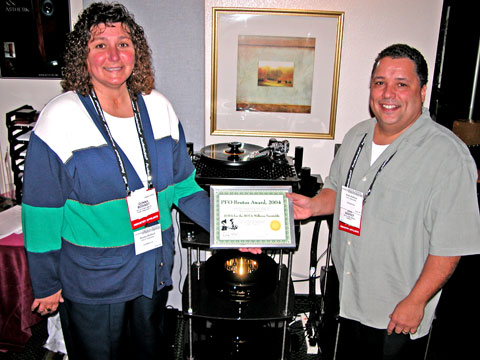
Donna and Kirk Bodinet with their 2004 Brutus
Award for the SOTA Millennia at CES 2005; the Millennia is immediately behind
the award.
Mating tonearm and cartridge …some useful
considerations
That brought up the next question, the one that
everyone in the market for at turntable has to decide before making a final
decision: what tonearm and cartridge should be used with the SOTA?
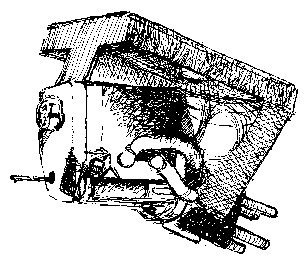
Without digressing too far on the subject, it's
important to understand that you can't simply toss any old cartridge on any old
tonearm and assume a happy marriage. For example, some cartridges (like, say,
one of the hefty Koetsu's) are heavy enough that some tonearms won't balance
properly with them, and so can't handle them. Beyond that, and briefly, you have
to consider the effective mass of the tonearm, the compliance of the
cartridge, the effective weight of the cartridge and its mounting system,
so that you can calculate the resonance frequency of a given tonearm/cartridge.
Physics dictates that a spring-loaded (the cantilever of the cartridge and its
associated compliance) mass (the combined effective weight of cartridge and
tonearm, properly set up) will have a given resonance frequency. This resonance
will be a point in the audio frequency spectrum that the tonearm and cartridge
will exhibit a resonant spike or hump of several dB or more due to their
mechanical synergy, which of course represents a major non-linearity in
performance. This resonance is an enemy of fidelity in LP playback, and may be
combated by various measures—the composition and dampening of the tonearm, for
instance—but the natural physical tendency will still be present.
The most important thing to do is to check the
resonance frequency of a given set of tonearm/cartridge parameters and make sure
that it is placed in a zone of lesser audio impact. Where is that? We can answer
that question by a simple process of elimination. If the resonance frequency
hump is above 20Hz, it will actually become audible in many systems and to some
ears; if it is 7-8Hz or less, it will boost turntable rumble/low frequency
groove noise and the distortions thereof. Turntable gurus therefore look for
tonearm/cartridge combinations that produce resonant frequencies of somewhere
between 9Hz and 14Hz—too high to magnify rumble, too low to be audible.
The calculation of this frequency involves a
formula, but fortunately for the math-wary, I have found a very helpful website
that gives a good overview of resonance and an excellent online calculator for
determining whether or not a given combination is in the "golden range" for
resonance. Point your browser at
http://www.mhsoft.nl/MySystem/rf.html, and plug in the requisite figures:
effective tonearm mass, effective cartridge weight, fastener weight, and
cartridge compliance (all of which should be available from the manufacturers or
distributors), the click on the "Calculate" button. The resultant resonance
frequency needs to be somewhere between about 9Hz and about 14Hz for you to
have an optimum marriage of tonearm and cartridge. Hats off to a very useful
site…this makes it easy.
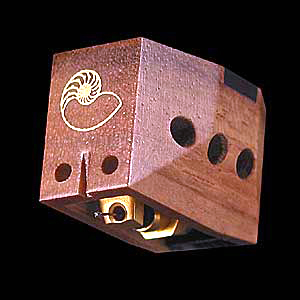
The Cardas Myrtle Silver Heart MC cartridge
(image courtesy of Cardas Audio)
Continuing, then: In our discussions, Kirk's first
take on this was to try pairing the SOTA Millennia with the finely crafted
Triplanar Precision tonearm (the Mk. VII). The Triplanar is a low-medium mass
tonearm, at 11 grams. (Note that tonearms of 10 grams or less are generally
considered to be "low mass," 11-25 grams constitutes the "medium mass" category,
while anything over 25 grams is in the "high mass" group. The basic rule: modern
low compliance MC's are normally mated with medium-to-high mass tonearms; high
compliance cartridges should normally be mated with low mass tonearms.)
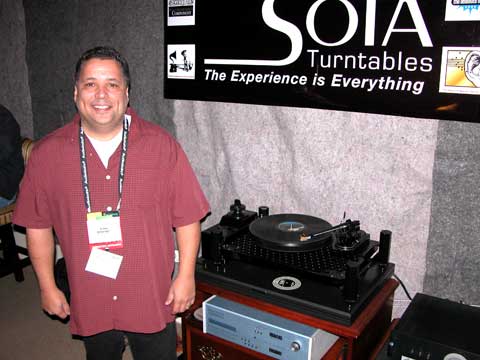
Kirk Bodinet at CES 2005 with the SOTA Millennia/SME
IV.Vi/Cardas Neutral Reference Cable/Cardas Myrtle Silver Heart reviewed in this
article.
To this we planned to add the Cardas Myrtle Silver
Heart MC cartridge, which Cardas lists as having a weight of 9.5 grams, a
tracking force of 1.8-2.0 grams, and a "dynamic compliance" of 15 μm/mN, which
is in the "moderate" range; see
http://www.cardas.com/content.php?area=products&content_id=7&pagestring=Accessories&product_id=58.
(I should pause for another educational footnote here: cartridge compliance is
generally sorted into "low compliance" at 5-10 μm/mN, "medium compliance" at
11-20 μm/mN, and "high compliance" at 21+ μm/mN, with "very high compliance" at
35Hz and above.) The Myrtle Silver Heart MC is itself a custom iteration,
developed especially by George Cardas, using the well-respected Benz family, and
highly prized for its detailed, yet musical presentation. This combination
should mate well—a moderate compliance MC with a medium mass tonearm—with an
approximate resonance frequency of 8.96Hz, an acceptable result.

The SME IV.Vi tonearm
Unfortunately, weeks after Kirk and I thought the
project was set, Triplanar ran into problems with its distributor at that time,
and had to withdraw from the project. So it was back to the drawing board for a
tonearm to handle the Cardas Myrtle Silver Heart. Fortunately, Kirk had contacts
over at Sumiko USA who were willing to ship him an SME IV.Vi tonearm, which
would also do the trick. According to the Sumiko website (see
http://www.sumikoaudio.net/sme/manuals/tonearms_seriesIV.VI.pdf), the IV.Vi
has an effective mass of "10/11" grams and can handle cartridges in the 5-16
gram range, making it another good match for the Cardas. The resonance frequency
on this match would be approximately 9Hz, also OK.
In order to expedite the review, Kirk did the
mounting of the SME IV.Vi on a SOTA armboard at his end, and then shipped the
turntable to me here in Portland for the assembly of the turntable and the
mounting of the Cardas cable and cartridge at this end. PFO's Senior
Technical Editor Jennifer Crock and her husband Michael Crock once again did
yeoman's work for me, and assured that the Cardas was properly mounted and
adjusted for the review project according to specification. Many thanks to them
both for their expert help.
Once the turntable had been assembled, Jennifer,
Michael and I shepherded the SOTA/SME/Cardas system upstairs and placed it.
Since the SOTA turntable itself is somewhat wider than my Vibraplane could
accommodate, the Millennia was put onto one of DJ Casser's very handy "The
Shelf" carbon fiber platforms, which was in turn put onto my trusty-rusty
Vibraplane. My rather long-in-the-tooth Target turntable stand provided the
foundation. Walker Audio's truly amazing Velocitor provided line conditioning,
with Silent Source Power Cables handling the electrons.
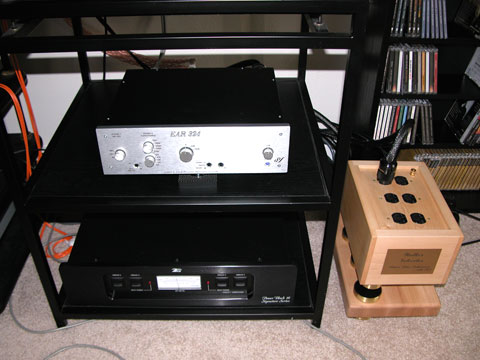
The E.A.R. 324 on Black Diamond Racing cones, placed
on the middle shelf of my Target turntable rack; the SOTA Millennia is on a
Vibraplane/Black Diamond Racing "The Shelf" stack, one layer up. Note the Walker
Audio Velocitor which provided juice to the E.A.R. 324 via Silent Source power
cables.
Once the turntable was in place, it was time to get
the SOTA vacuum hold-down motor in place. (I'll address the function of this
motor below, for those who aren't familiar with vacuum systems on turntables.)
The key to placing vacuum motors of this kind is pretty simple: how noisy is the
motor? Some vacuum motors are quieter than others; some listeners are very
sensitive to even quiet units if the sound is constantly present during LP
sessions. The sound of a vacuum motor can become a real irritant in that case,
and the motor will need to be placed outside of the listening room, but close
enough to the turntable for proper operation. None of us were familiar with the
SOTA unit, so didn't know if it was whisper quiet or sounded like an aquarium
pump on steroids.
After some discussion, Jennifer, Michael and I
decided to place it in the room on my left-most Michael Green rack, furthest
away from the listening position and the turntable, but close enough to be used
easily. We would assess the noise level later, and re-position it at need.
Meanwhile: don't forget the cartridge output and
the phono amp!
Another very important aspect of turntable
performance is the matching of MC output and loading at the phono amp. (I am not
addressing moving magnet, or MM cartridges, in this article, since I do not use
them.) Various MC cartridges have outputs that range from "low" (approximately
.2mV - .3mV) to "medium" (approximately .4mV - .6mV). By comparison, your
typical SACD or CD player usually outputs 2.0 Volts. To handle the amplification
of such a tiny signal to a minimum 1.0 Volt threshold for proper use by your
line-level preamp, you need to be sure that you have either a phono amp that is
specifically designed for a given turntable system (e.g., the Linn Linto, or the
Walker Audio Reference Phono Amp, Second Edition), a phono amp that is sensitive
enough for the output signal, and is internally or externally configurable for a
number of different possibilities (e.g., the E.A.R. 324, or the Manley Labs
Steelhead, both of whom have inputs for either MC or MM use), or a step-up
transformer that can hoist your signal far enough to feed your line pre
properly.

Tim de Paravicini's superb E.A.R. 324 phono amp
Additionally, proper cartridge loading—the
impedance of a given cartridge—must be dialed in for best performance. The
loading of MC cartridges usually ranges from about 100 Ohms to 47K Ohms. Cardas
recommends operating in the 500-47K Ohm range. (As a useful guide, Cardas notes
that for the Cardas Myrtle Heart on a very quiet audio system can go to a 47K
Ohm setting. Audio systems that are subject to noise should move to the 500-1.5K
Ohm portion of the loading scale. This lower setting also applies if the
cartridge is not yet broken in. My Linn Akiva, by comparison, likes 100 Ohms in
my system pretty well.)
For this review, I used my E.A.R. 324 phono amp, a
remarkable and versatile component with real world-class performance. Depending
on the configuration set by the user, the E.A.R. 324 can provide up to a whopping
72dB of gain for MC's. The 324 is quiet, clean, and flawless in operation. (As
a matter of fact, it's so good that I gave it a Brutus Award in 2004 and
purchased the review sample; see my review in Issue 15 at
https://positive-feedback.com/Issue15/324.htm.) With the 324 in place, I
was sure of pulling everything possible out of the rather lowish .3mV output of
the Cardas.
I plugged the Cardas Neutral Reference phono leads
into the E.A.R. 324's Phono 1 input (MC), and set the loading at 40 Ohms. (Note
that this loading is a transformer loading figure, and not a resistive
loading. According to E.A.R., 40 Ohms on the 324 equates to a 500 Ohm resistive
value, which was just fine for this project, since the Cardas MC was still low
mileage.)
I was now ready to fire the SOTA up. But before
reporting on the sound …another digression.
The SOTA approach to LP playback, and an
introduction to the differences in the turntable arts…
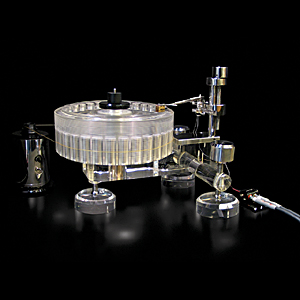
The La Luce CS Centoventi, a belt-driven,
non-suspended approach with pivoted tonearm, record clamp and no vacuum
hold-down (image courtesy of Cardas Audio)
Different turntable designers have differing
convictions about two other important aspects of turntable configuration:
suspension, and how LPs should be handled on their turntable platters. Broadly
speaking, turntables can be divided into designs with various takes on a
suspended platter/drive chassis (e.g., the Linn LP-12, the SOTA Millennia, the
Basis line, and the SME 30) and those without (e.g., either of the La Luce, the
Clearaudio line, the Transrotor line, Redpoint Audio, Teres Audio, Galibier). If
you have a non-suspended turntable, you have a very solid foundation that
directly couples the turntable to its supporting shelf/stand. You'll generally
deal with the nastiness of vibration by paying deep attention to the isolating
properties of the platform/shelf system that you place a non-suspended design on
(e.g., a Vibraplane).
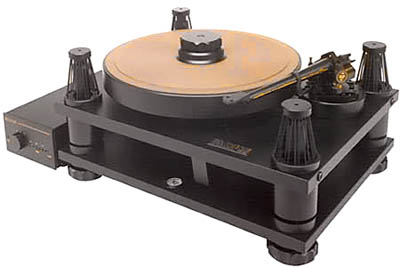
The SME Model 30/2A, a direct-drive, suspended
design with pivoted tonearm, record clamp and no vacuum hold-down (image
courtesy of Sumiko Audio USA)
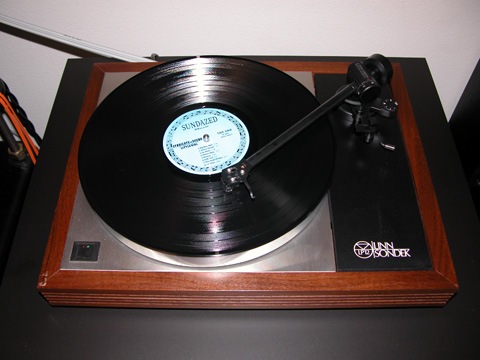
The Linn LP-12, a direct-drive, suspended design
with pivoted tonearm, no record clamp and no vacuum hold-down
Suspended models try to build such vibration
isolation into the chassis/sub-chassis of the turntable itself, and usually (but
not always …see the LP-12, for a classic example) add more vibration control with
record clamps, to assure a firm purchase on the LP. Vigorous partisans exist for
both approaches, and reference-grade implementations exist for either design
path. (We have included photographs of various examples and combinations of
these; these are by no means a comprehensive catalog, and are intended to be
merely illustrative. You'll note the great variety of approaches even in this
small gallery of images.)
There's also the question of whether or not a
turntable uses some sort of system to bind the LP to the platter, thus
increasing (in theory) the degree of control over the LP while it is in motion.
Many turntables employ a record clamp to greater increase the purchase of the LP
to the platter; others use vacuum system as well to flatten the LP; and some do
neither, allowing the LP to simply rest on the platter (quite often using a
turntable mat of some kind to dampen vibration).
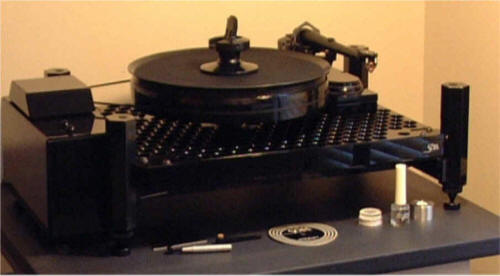
The SOTA Millennia, another belt-driven,
suspended design, featuring pivoted tonearm, record clamp and vacuum hold-down
(image courtesy of SOTA)
Then one must consider the motor system used to
drive the platter. Most fine turntables use belt-driven apparatus (or some
variant, like the band drive of Galibier Design), or even silk-thread-driven
approaches. This has the advantage of off-loading the mass and most of the
vibration of the motor drive from the turntable itself, although the problem of
thread/belt/band "bind and go" (traction and purchase on the platter, followed
by slippage, followed by a repeat of the cycle), leading to non-linearities in
the stability of speed control, remain a design challenge. The alternative is to
use direct-drive motors, whose force is applied directly to the platter from
underneath. This eliminates "bind and go," but also more or less directly
couples the motor and its vibration to the platter, and places a premium on the
linearity of the motor's application of energy. Both alternatives offer a
collection of obstacles for the designer to overcome.
Regardless of the drive system chosen, one must also
choose how the greater or lesser mass of the platter is to be suspended for
minimum friction and wear and for maximum precision of platter rotation. Most
designers do this with bearings of various composition (metals like zirconium;
gemstones like sapphire), inverted or not, in a well of one kind of lubricant or
another. Some few have opted to skip surface contact of metal or gemstone on
metal and float their platters on some sort of "air bearing" (e.g., Walker
Audio) or magnetics (e.g., the Platine Verdier, or the new prototype E.A.R.
turntable by de Paravicini). As a general rule, the further one moves from
metal/gemstones plus lubricant bearings to air or magnetics, the greater the
engineering challenge, and the higher the consequent price. The closer one comes
to the theoretical ideal of a "platter floating upon nothing in a vacuum," the
nearer one approaches the ideal of a frictionless, completely decoupled
propulsion/suspension system for the LP. Such a system, in theory, would produce
the foundation and propulsion for the greatest purity of playback signal from
the grooves of an LP.
Finally, one can design a turntable that uses a
pivoted arm of the kind familiar to all of us, or use one form or another of a
linear-tracking tonearm. Both have plusses and minuses. In theory, a linear
tracking tonearm maintains a more consistently correct perpendicular
relationship with the record groove, mimicking the geometry of the original
cutting stylus used to cut the LP. Unfortunately, executing that simple sounding
task is fraught with engineering challenges. One either has to use some sort of
electro-mechanical servo control to provide tracking—which simply controls the
degree of error—or has to provide an air bearing system to let the tonearm
"float" with the cartridge's movement in the groove, thus minimizing drag and
imbalance during playback. Both pose serious difficulties to overcome if one is
to achieve correct groove geometry; few have done this successfully.
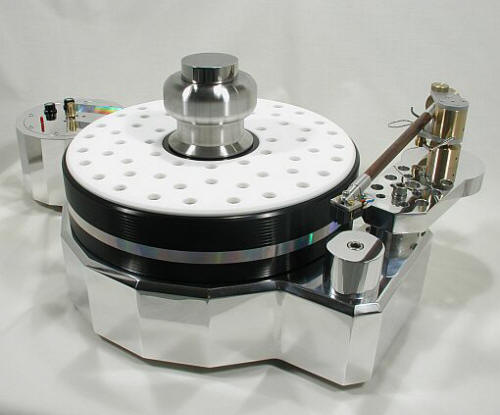
The Galibier Design Stelvio, a band-driven,
non-suspended design with pivoted tonearm (a Schroder in this case), record
clamp and no vacuum hold-down (image courtesy of Galibier Design)
Most turntable designers have therefore gone the way
of the venerable pivoted tonearm. There is a much wider array of available
solutions, and dealing with the mounting and the logistics of support is
generally easier. But the use of pivoted tonearms is no bed of roses, either.
The challenges there include a multitude of tonearm bearing problems, dealing
with the geometry of a more or less constant offset from the perpendicular with
respect to the groove (and thus significant non-linearities across the surface
of an LP), and minimizing the effects of that offset (e.g., anti-skate
settings).
Fair warning: the esoterica of tonearms is enough to
drive all but the most dedicated to the nearest bottle of aspirin, which is why
the setup and support of many combinations is a declining audio art. The
response of some manufacturers (e.g., Linn, SME, Walker Audio, Clearaudio) has
therefore been to standardize the preferred configurations of tonearm and
cartridge with their turntables as much as possible, to optimize performance and
minimize support problems in the field.
I sympathize completely.
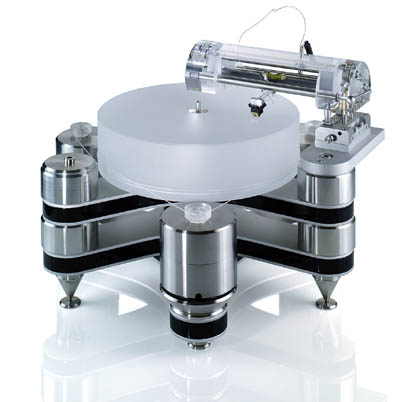
The Clearaudio Master Reference, a belt-driven,
non-suspended design that will handle up to three tonearms (either pivoted or
linear-tracking), record clamp, and no vacuum hold-down (pictured here with the
linear-tracking Clearaudio Master TQ-I tonearm; image courtesy of Musical
Surroundings/Clearaudio)
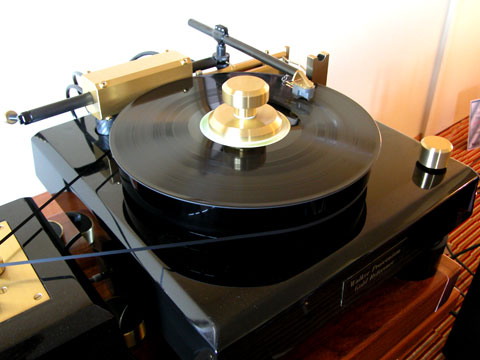
The Walker Audio Proscenium Gold Signature
turntable system, a belt-driven, air-suspended system with air-bearing
linear-tracking tonearm, record clamp, and no vacuum hold-down
End of digression, at last. Applying the above
considerations to the SOTA Millennia, I can summarize its design as a
belt-driven, inverted bearing, four-point suspended turntable for pivoted
tonearms. It combines a light-moderate mass record clamp—the SOTA Reflex Clamp—with a vacuum hold-down system rated at 3.0" Hg (equaling approximately 1.47 psi) applied to a 15 pound platter. The total platform is of moderate weight, at
44 pounds, exclusive of the pump and motor assemblies, each at about 20 pounds.
The Millennia vacuum system represents the current
peak of SOTA's design practice, and was reviewed as their reference-level
design. The coupling of the Millennia with the SME IV.Vi and the Cardas Myrtle
Silver Heart and Cardas Neutral Reference Cable represents a very rational
mating of components—how would it perform?
The Sound
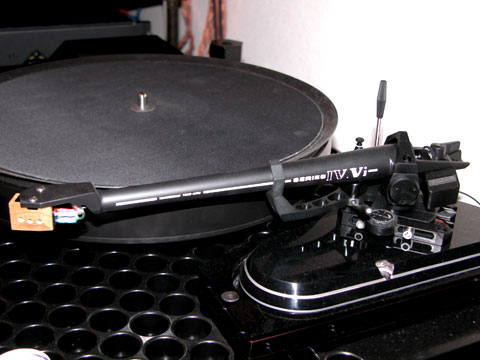
The SME IV.Vi tonearm and Cardas Myrtle Heart MC
on the SOTA Cosmos armboard; in the background, you can see the SOTA vacuum
pass-through mat on the platter
The first good news to report is that I was very
impressed by the quietness of the vacuum hold-down pump that came with the SOTA
Millenia. I had been concerned that I would have to move it immediately from its
very convenient shelf to my media room next door. This was not impossible, but
would have been a pain to do. No worries, though: the pump was so quiet that, at
first, Jennifer, Michael and I actually though that it was broken. We didn't
hear anything, so we turned the unit on and off a time or two, trying to
diagnose the problem. Michael finally noticed that there was power to the
turntable, and that the Millennia was working, the vacuum waiting for us
to drop an LP on the platter. Even after LPs were in place, the SOTA system was
almost imperceptible.
That, my friends, is quiet.
The platter of the Millennia has what looks like a
mat in place, on first glance. Then you realize that it is a special material
through which the vacuum is drawn, to hold down the record without harming its
surface or grooves. At the rim of the platter is an upturned rubber gasket,
providing the seal necessary to complete the vacuum's holding action. This is
activated in the simplest manner possible: you put an LP on the platter, and
within seconds the vacuum pulls the record flat on the rubber seal. There's an
ingenious auto-sensor that detects the presence of an LP and activates the
hold-down system, making this step fairly foolproof.
I found operating the Millennia to be very
straightforward. You clean your LP or LPs, turn on the turntable vacuum, drop an
LP in place, apply the SOTA Reflex Clamp, and then turn on the drive motor.
You're ready to queue your record. It only took us a few minutes to get the feel
of the SOTA system, even though my experience with vacuum hold-down turntables
has been very limited, there being so few of them….
Before running out the turntable and settling in for
a listen, Jennifer strobed it for speed accuracy, and double-checked the
alignment and configuration of the stylus. Once we were satisfied that all was
well, I took out one of my "run out the turntable" LPs, played it through a few
times, then let the stylus play with the run-out groove overnight. Over the
following couple of days, I ran several of my Classic Records RCA LSC's at the
Millennia—the Respighi, Scheherazade, Witches Brew and the like—to exercise the cantilever and put some signal through the MC's magnets and
the new Cardas phono cable. After a few days, the initial light congestion of
sound began to wear off, and LP playback began to bloom. The moment was right:
because my time for listening to this combination was relatively short, I sat
down to begin my serious listening over the next several weeks.

The Linn Akiva cartridge, in fresco
Baseline: Notes on the Linn Akiva/Lingo II/Linn
silver phono cable
The SOTA/SME/Cardas was different in presentation
from what I was used to with my top o' Linn's line LP-12 system. Let me explain
what I mean, since you have to know where I've been to understand where I'm
going. The arrival of the Lingo II, the latest revision of the Akiva cartridge,
and the Linn silver reference phono cable had changed the well known aural
complexion of my LP-12 from a punchy, musical platform with lots of Art Dudley's
PRAT (Pace, Rhythm And Timing) and a great "boogie factor"—what my good friend
Scott Frankland had once correctly described as "always musical"—to a much
more detailed, extended canvas. The new LP-12 still had a fine sense of the
heart and drive of the music, but where the Arkiv/Cardas Golden Cross phono
cable/Ekos/Lingo I had previously focused on a thumping great bass and
excellence of musical rhythm, the Akiva/Ekos/Lingo II/Linn Silver extended the
sense of spaciousness, presence, and three-dimensionality in a very noticeable
way.
It was almost as if Linn had made the deliberate
decision to extend the upper frequencies and pursue greater transparency with
their venerable LP-12. The Lingo II power supply certainly gave an increased
sense of deep silence and rhythmic control, while the Akiva/Linn silver phono
cable attained a kind of airiness in the upper ranges that explored new sonic
ground for Linn. In all my years with my LP-12 …now up to 16 or 17 or so …this was
one of the most significant improvements that I'd heard. (That Linn keeps coming
up with great improvements like the Akiva and the Lingo II is one of the great
long-running stories in fine audio.)
And this was the analogical sonic context that the
SOTA Millennia/SME IV.Vi/Cardas Myrtle Silver Heart/Cardas Neutral Reference
entered—a tough act to follow!
Back to the Chase!
Over several weeks I got a feeling for what this
system offered. In the first place, and my first impression, was that the vital
midrange was quite delicious. This is no surprise; George Cardas designed this
cartridge, and nothing that George builds will ever sin against musicality.
After passing through the brief slough of congestion that cartridges pass
through during break-in, the Cardas bloomed and the midrange came into its own.
Its character via the SME/Cardas Neutral Reference phono cable became clear to
me. The tonal balance of the mids did not have the same slightly rich and
luscious presentation that the Cardas Golden Cross cables provide; the "neutral"
in Cardas' Neutral Reference designation is accurate. Instead, the SME/Cardas
cable brought the cartridge back to a lightly cool sonic presentation, with the
slightest emphasis on detail.
The SME arm seemed to synergize well with the Cardas
and with the table; there was a firm sense of control and clarity. I heard no
resonant nasties in the SOTA/SME combo, either in the table or in the tonearm. A
minor point: tonearm students should note that the SME IV.Vi's dampened cueing
is not as slow and elegant as that of the Linn Ekos; you have to be careful
about how you drop the stylus into the groove. This is no problem, but something
that you should be aware of.
The sense of rhythm was different with the SOTA
Millennia system than I had been used to with the new LP-12. There is a definite
sense of musical virtues I associated with the Cardas MC—tonal richness,
top-to-bottom proportionality, rhythmic rightness—but also clearly a
foundation of control in the Millennia/SME platform and the SOTA vacuum
hold-down and record clamp, which tightened up the bass and brought a heightened
emphasis to detail. (I think that some of the detail emphasis I was hearing
might be attributable to the cable; those looking for more richness/warmth would
likely find it simply by shifting to the Cardas Golden Cross on the phono
cable.) The synergy between the musicality of the Cardas MC and the
detail/control of the SOTA/SME created a dynamic balance between the two, and
kept the listening experience at a neutral/very lightly cool place. (For Rick
Gardner's brief notes on the Cardas Myrtle Silver Heart MC on a very different
turntable, read his sidebar elsewhere in this issue.)
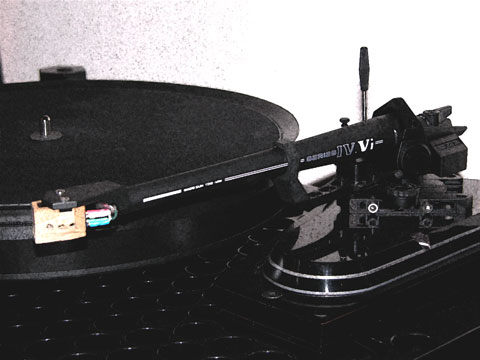
Throughout my sessions with it, the SOTA Millennia
was flawless. It was quiet, and its vacuum hold-down system never intruded on my
listening sessions at all. The vacuum handled every LP that I loaded, even a few
that were not quite as flat as I would have liked, and the SOTA Reflex Clamp was
straightforward in its operation, once you get the hang of it. (Jennifer Crock
pointed out that you have to be firm in applying it in one definite movement,
since the platter bearing doesn't appreciate the jitter of "on-again, off-again,
what the heck am I doing?" clamping. Kirk at SOTA can give you some advice
here.) No matter the LP, the Millennia handled it with ease, and never left me
wishing that I was listening to something else. If my experience is indicative,
the Millennia is certainly a well-behaved turntable. Those concerned about the
complexities of a vacuum-based turntable system have nothing to fear.
Overall, I enjoyed my all-too-brief time with the
SOTA Millennia/SME IV.Vi/Cardas turntable system. The combination proved to be
musical, controlled, nicely detailed, and engaging. As I observed, listeners who
prefer warmth or richness in their LP playback will want to look to the Cardas
Golden Cross cable instead of the Neutral Reference, which should give them just
the right touch of magic. SOTA's Millennia should provide a fine platform for
other tonearms and MCs as well; heck, I'd love to hear it with a Graham, a
Schroder, or a Moerch. Given the performance I observed, the Millennia would do
exceptionally well.
I therefore awarded the SOTA Millennia/SME IV.Vi/Cardas
Myrtle Silver Heart MC/Cardas Neutral Reference phono cable system Brutus Awards
in 2004.
Specifications
For details/specifications about the SOTA Millennia,
see
http://www.sotaturntables.com/Millennia.htm.
SOTA Millenia w/Cosmos arm board and vacuum
hold-down
Retail: MSRP of US $7750
(Note that SOTA builds these configurations upon
order as a custom job; allow time for completion of the work. Check with SOTA
for a timetable at the point of order.)
SME VI.Vi tonearm
Retail: US MSRP $3499
Cardas Myrtle Silver Heart MC
cartridge
Retail: US MSRP $2775
Cardas Neutral Reference Phono Cable
Retail: US MSRP $294
Grand turntable system total: US $14,318 (does
not include shipping/handling/insurance charges; also does not include the
Walker Audio Velocitor and Silent Source power cables used for turntable line
conditioning, and the Sound of Silence Vibraplane).
Manufacturers
SOTA
10830 S. Nagle, PO Box 247
Worth, IL 60482
TEL: 800. 772. SOTA
web address:
www.sotaturntables.com
email address:
[email protected]
Cardas Audio
web address:
www.cardas.com
Sumiko USA
web address: www.sumikoaudio.net
|



















